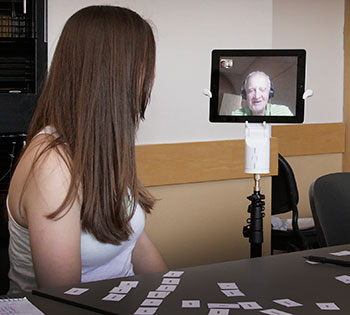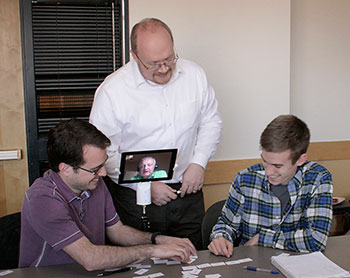
A Remote Seat at the Table
Setting our students up for success is a top priority for CU Boulder, but how can we help students who leave campus before completing their degree? Of course, some can benefit from expanded offerings of online classes, but is there another solution for those students who need to complete a seminar or smaller face-to-face course that’s not offered online? Could we still help them?
Successful Pilot
 This past spring, the Office of Information Technology’s (OIT) Academic Technology Design Team partnered with Instructor Giorgio Corda (Department of French and Italian) and a senior auditor/student to pilot the use of a Kubi (pictured right). Kubi is a stand that holds an iPad which allows remote users to control their classroom view and perspective while videoconferencing.
This past spring, the Office of Information Technology’s (OIT) Academic Technology Design Team partnered with Instructor Giorgio Corda (Department of French and Italian) and a senior auditor/student to pilot the use of a Kubi (pictured right). Kubi is a stand that holds an iPad which allows remote users to control their classroom view and perspective while videoconferencing.
The student was looking for a way to effectively continue his language studies remotely and Kubi seemed to be the perfect solution. Unlike other technology options, such as a video conference screen that may be affixed to a wall, Kubi allowed the distance student to control his perspective of the class remotely by panning, tilting and turning the iPad in any direction; essentially, giving the distance student a seat at the table.
Through Kubi, the distance student took part in this highly interactive foreign language class in much the same way as the classroom students. He played language games, solved vocabulary puzzles, gave presentations, and participated in other group activities. The instructor designed or redesigned classroom activities to incorporate the distance student. “Revisiting each lesson plan with a backward design approach allowed me to take full advantage of the Kubi’s potential,” said the instructor, Giorgio Corda. “For instance, by considering the movement afforded by th e Kubi I created Total Physical Response activities, which seemed to positively influence the learning environment for all students. This was vital in deciding which activities could be implemented as they were, and which ones needed some adaptation.” One student in the pilot class noted, “I'm really not a fan of most technology, but I'm happy that the Kubi allowed [the distance student] to participate in the class, and that other people were able to interact with the Italian language in a new way (by speaking to [him] thru the iPad).”
e Kubi I created Total Physical Response activities, which seemed to positively influence the learning environment for all students. This was vital in deciding which activities could be implemented as they were, and which ones needed some adaptation.” One student in the pilot class noted, “I'm really not a fan of most technology, but I'm happy that the Kubi allowed [the distance student] to participate in the class, and that other people were able to interact with the Italian language in a new way (by speaking to [him] thru the iPad).”
The technology was easy to use and reliable over the course of the semester. The distance student reported that attending class on a Kubi met his needs, and students physically in the classroom said the Kubi did not negatively affect their learning.
What’s Next for Kubis on Campus?
Based on the success of this pilot, OIT will continue to partner with CU’s academic units to explore other promising uses of Kubis on our campus. “We’re excited about the possibility of using Kubis to bring other distance students into our face-to-face classes since it allows them to participate and play an active role in the class,” said Courtney Fell, OIT Learning Experience Designer. “We recognize this technology has implications around pedagogy and support that merit further investigation, but we owe it to our students to explore a wide range of solutions to provide them with the flexibility to complete their degree at our university, even at a distance.”
This semester, we will further track the possibilities of using Kubis in the classroom thanks to a development grant from ASSETT, awarded to Jean Bouchard, Director of the Center for Language and Learning and Coordinator of the Modified Foreign Language Program (MFLP).
Using student grade data for the foreign languages, Bouchard has identified students at-risk for failure in foreign language and is providing them a means to complete their degrees despite having left the Boulder region. Kubis will bring multiple distance students into a modified Spanish 1010 class and will be further supported by other synchronous technologies such as a virtual whiteboard that allows all students to collaborate on writing activities.
“We believe the integration of Kubis for our distance students, which allows them to be seated adjacent to our in-class students, will promote even more collaborative opportunities and will stimulate better small group interactions and activities,” says Bouchard.
Learn more about the Kubi pilot on the Office of Information Technology (OIT) website or reach out to the Academic Technology Design Team to explore how technology can enhance our students’ learning experiences.
